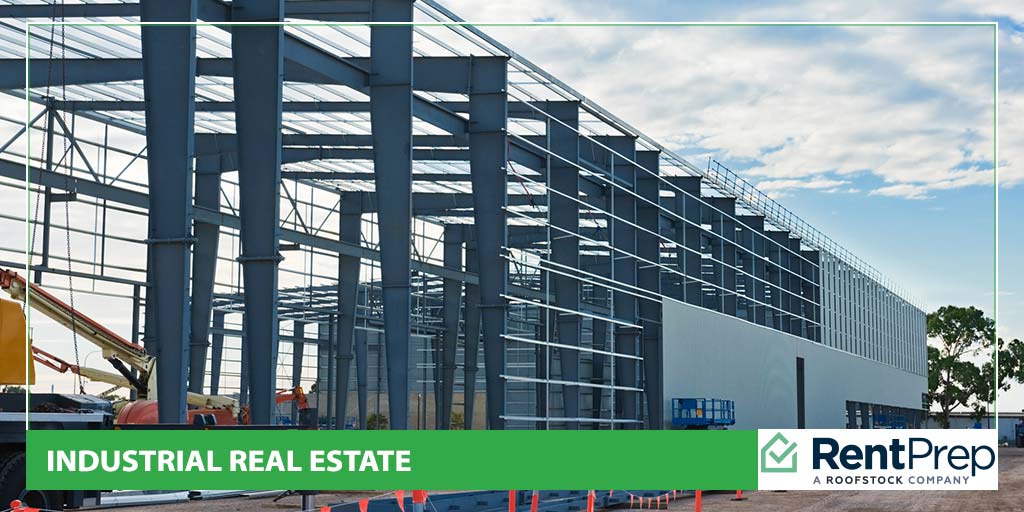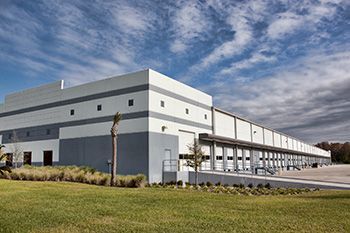
Industry, industrialization, industrial strength: these words share a common root and meaning. How does industrial real estate fit into this profile?
Industrial real estate is a common investment option for investors, especially in transportation hubs worldwide. Are you missing out on opportunities for future growth and big profits by staying away from industrial real estate?
Unknown investing options intimidate many investors, but growing your portfolio requires reaching out for something new. Today, follow along with our guide explaining industrial real estate and the potential benefits of investing in it. You don’t want to risk missing this opportunity.
A Table Of Contents On Industrial Real Estate
What should all landlords and investors know about industrial real estate? Follow along for a deep look into this sector of the rental industry:
- What Is Industrial Real Estate?
- Types Of Industrial Real Estate Properties
- The Value Of Investing In Industrial Property
- The Risks Of Industrial Property Investing
- FAQs On Industrial Property Investing
- The Reality Of Industrial Property Investing
What Is Industrial Real Estate?

Industrial real estate is defined as property, including land and buildings, where industrial activities occur. These include assembly, manufacturing, research, distribution, logistics, production, storage, warehousing, and similar industry activities.
Every city has zoning requirements for property within its boundaries. Most industrial properties are zoned into areas where they can operate safely without causing distress or disruption to residents and other businesses. These zoning ordinances can be stringent, indicating which industry activities can occur in which locations.
The industrial sector is a large one. There are many subdivisions, so remember that today’s guide and examples may not touch every industrial real estate property type.
Types Of Industrial Real Estate Properties
Industrial real estate properties comprise all the land and buildings where industry activities occur. What does this mean at the ground level? Let’s run through the primary categories of industrial properties nationwide.
#1: Heavy Manufacturing
Heavy manufacturing locations require highly specialized equipment and machinery to manufacture products.
These facilities often span tens or hundreds of thousands of square feet. Loading docks, large stockyards, and on-site power supplies are commonly seen at heavy manufacturing properties.
#2: Light Manufacturing
The majority of manufacturers are considered light. At light manufacturing properties, goods and products are created through less capital-intensive means. Portable equipment is easily rearranged and reconfigured as needed.
Overall, the amount of supply and product needed for production is much smaller when compared to heavy manufacturing.
#3: Warehouses
Distribution and general warehouses also qualify as industrial properties. Distribution warehouses focus on shipping goods, while general warehouses store products that are not being rapidly processed and shipped.
#4: Flex Spaces
Many industrial real estate properties are developed into flex spaces. These spaces can be used in different ways by different tenants.
Typically, there is a 70:30 ratio of warehouse-to-office space in these properties. The flexibility of these properties attracts many tenants without the need for constant redesigns.
#5: Research Buildings
Research and development properties meet in the middle of industrial and commercial office spaces. These properties typically feature a mix of office, warehouse, and manufacturing space.
Tenants here often research and develop technology-based products, but these properties have a wide range of potential uses.
#6: Data Centers
Specialized buildings outfitted for computer servers, telecom functionality, cloud storage options, and more are popping up everywhere.
These industrial sites keep companies online and connected. Companies expanding their services often add more data centers in key areas, which can be a good opportunity for investors in that region.
The Value Of Investing In Industrial Property
What do you risk missing out on if you don’t consider investing in industrial properties? Let’s find out as we investigate the value of this sector.
High Demand
Industrial property vacancy rates are lower than other commercial real estate types. This is largely due to the adaptability and accessibility of many industrial properties. Large industrial properties such as warehouses can be outfitted into multiple types of space, which attracts tenants with unique needs.
Flexible Spaces
Most industrial properties have many flexible use cases. From warehouses to data centers to showrooms, it’s possible to adapt a single space into many different layouts.
This flexibility makes it possible to adapt to the changing market from year to year. For example, as e-commerce continues to grow, distribution warehouses are being adapted into fulfillment and distribution centers.
Better Yields
Many investors report higher yields from industrial spaces than comparable retail and office spaces. Industrial spaces bring in up to 7.5% returns, while office and retail spaces bring in 5% and 6%, respectively.
Long Lease Periods
Industrial property leases are often long-term contracts. Industrial companies setting up large warehouses or manufacturing facilities spend a lot getting everything ready to go, and they won’t easily waste that investment. Instead, they’re likely to become long-term tenants as long as the facility continues to meet their business needs.
This is why leases of two or more years are not uncommon in the industrial sector. These leases can secure long-term income if structured properly, offering a lot of security as you move forward with your business.
Reduced Maintenance Costs
Some industrial properties see lower maintenance costs than retail properties of a similar size. This is likely due to the nature of the properties. While retail spaces have many walls, elevators, and internal structural needs, industrial spaces are often just large, open rooms. Concrete floors and high ceilings make these spaces easy to maintain.
The Risks Of Industrial Property Investing

In real estate, benefits always come alongside some risks. Industrial real estate is no exception. Learn about the primary risks associated with investing in industrial properties below.
Vacancy Risk
Though industrial properties have lower vacancy rates than other commercial property types, the vacancy risk is higher than what is seen with residential properties. Finding tenants to fill vacancies takes time, so you must be prepared to cover these vacant periods.
The Cost Of Investment
Banks and other lenders consider commercial property investment riskier than residential investment. This means that rates on loans and other banking fees will be higher when working on a commercial property deal.
Constant Change
All real estate markets are constantly changing, but the change seen in the industrial sector brings up unique challenges.
The industry grows and evolves as quickly as the companies and technology working behind the scenes. If the industry standard begins to require higher ceilings for new machine technology, for example, your building might need renovation to once again be in demand.
Paying attention to market changes and trends within variest industry sectors will help reduce the risks of this type of impact.
The Wrong Investment Type
Does investing in commercial property make sense for you?
There is no one-size-fits-all solution in investing. Commercial property purchasing and management is a unique challenge, even for those experienced with residential properties. Successful commercial property investors know how to evaluate properties to choose the right investments.
Each investment approach requires different skills and has different end goals. Additionally, you have different commercial landlord responsibilities. If none of the commercial investment strategies that you consider fit within your long-term business goals, it might not be the right time to move into this sector.
Keep Learning, Keep Growing
From commercial real estate to industrial properties to large-scale residential rentals, there’s always more to be learned in the real estate investment industry. Do you feel you often fall behind on the latest news for landlords and investors?
That’s where we come in to help. Our regular newsletters and guides give you the knowledge you need to keep growing your business. Stay updated by signing up for RentPrep’s newsletter today.
FAQs On Industrial Property Investing
Still curious about what goes on in the world of industrial property investing? Here are the answers to some of the most commonly asked questions about this field.
What is an example of an industrial property?
Industrial properties are those with land and/or buildings used for industrial business activities. These properties include factories, data centers, research plants, logistics operation centers, warehouses, and many other types of business-use property.
Here are more examples of industrial properties that you may find in your area:
- Construction companies
- Power plants
- Chemical factories
- Storage and transportation warehouses
What is the difference between commercial and industrial property?
Industrial and commercial properties are both types of commercial real estate, but there are some differences in what these terms refer to.
Commercial buildings are used for commerce and business operations, such as workplaces, offices, and stores. Industrial properties house factories, warehouses, and other buildings where manufacturing occurs.
What are other types of commercial real estate investment types?
As mentioned, industrial properties are not the only type of real estate investment option you have if you’re considering expanding into the commercial real estate sector.
There are four primary categories of commercial real estate:
- Offices
- Multifamily properties
- Retail locations
- Industrial properties
The lease length and terms for each of these types of properties vary, but most commercial real estate investors utilize leases of two or more years due to the nature of how each property will be used. In the case of multifamily properties, shorter leases with individual residential tenants are common.
Many residential investors and landlords naturally move into managing multifamily properties with four or more tenants before moving into other types of commercial real estate.
Landlords often find that managing retail and office commercial real estate is more accessible than industrial real estate. However, industrial real estate often has a more significant profit margin, so it’s also worth considering expanding into this sector.
Is industrial real estate profitable?
Compared to retail and office spaces, industrial real estate properties show a higher return on investment (ROI). Traditional commercial real estate spaces usually see an ROI of around 5%; industrial real estate returns often fall between 6-8%.
As with any investment, there is no guarantee these are the returns you will see. Every situation is different, and you should remember this when deciding the best next step for your business.
What should I look for when investing in industrial properties?
Experienced investors in the industrial real estate sector have a lot to say about succeeding in this industry. Still, most advice comes back to identifying the right investment property. You need to focus on the most important aspects of the property when choosing how to proceed, just as you would when investing in residential properties.
In the industrial sector, these are the key factors to examine when researching potential investment properties:
- Location – Choosing properties with good access to transportation options is critical; access to other industrial assets is a huge bonus.
- Market – What types of properties are needed in the current market? Do businesses need large warehouses with no office space or a mix of both? Research this before proceeding.
- Tenancy – What types of tenants will be ideal for filling the property, and will these be reliable tenants in the current market?
- Lease options – Leases need to be able to match local benchmarks. Can you charge competitive rent without losing money with the property in question?
- Specialization – Does the property house any specialized equipment that attracts specific clients? Depending on the nature of the equipment, this can be positive or negative for investment potential. Research the region to determine if this will attract a niche audience or scare potential tenants away.
- Site Coverage Ratio – Site coverage refers to the ratio of yard space to actual building space; different businesses will have different needs. Most industrial tenants seek buildings with a higher ratio of land than buildings.
The Reality Of Industrial Property Investing
Industrial property investing brings unique concerns and opportunities to the table. Whether this is your first foray into commercial real estate or you want to expand your commercial portfolio, the options within industrial property investing are expansive.
Remember to do the following as you begin this journey:
- Consider the gaps and needs in the local industrial rental market; can you help fill that gap?
- Determine what your ideal tenant looks like and what they need most; how will you meet their demands?
- Think about the property’s future. Will it work long-term as an industrial location or need to be rezoned into a different investment type?
Industrial properties are an excellent option for investors looking to get into an area with an eye for potential rezoning in the future. Areas rapidly industrializing or changing to other commercial properties offer unique investment opportunities to those willing to take the risk. Are you ready?

